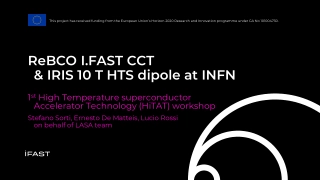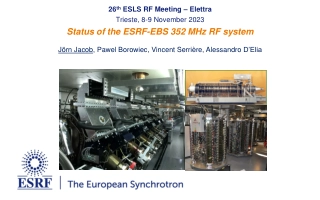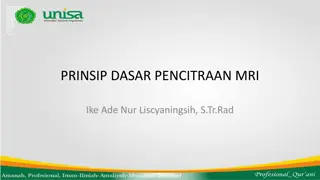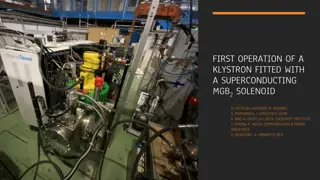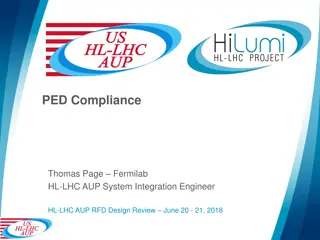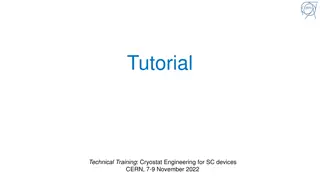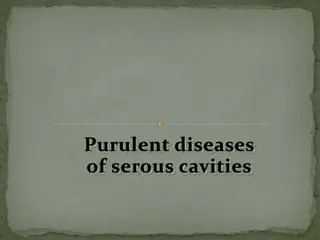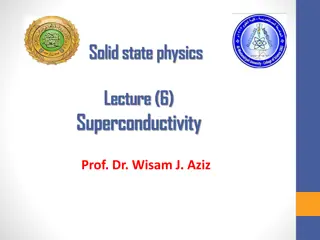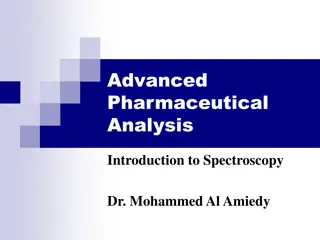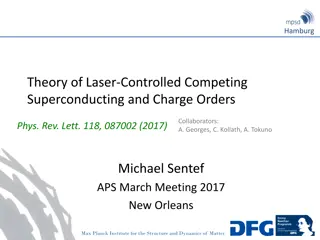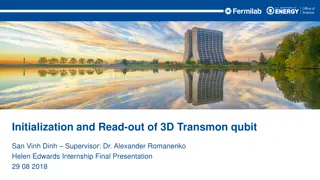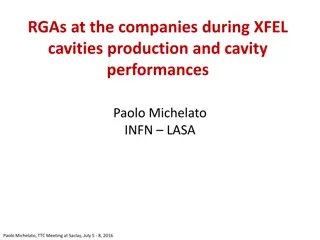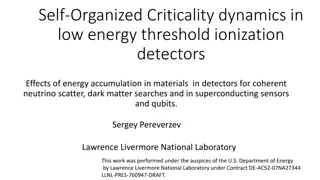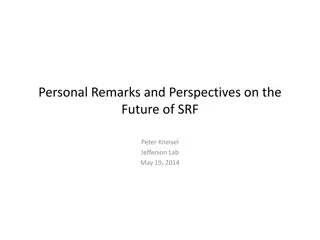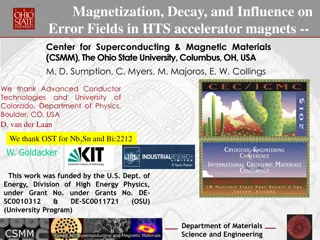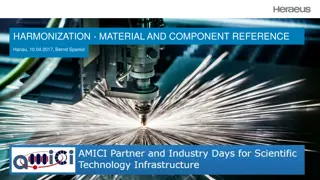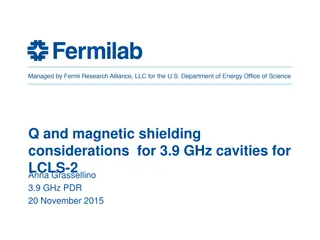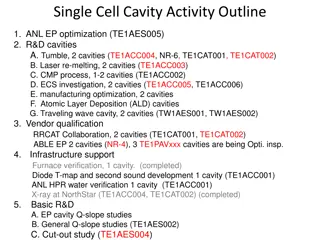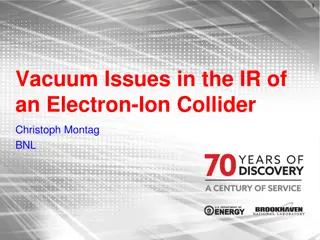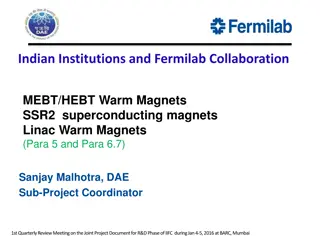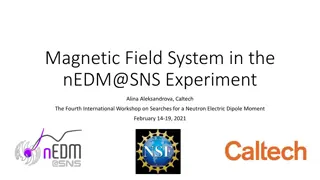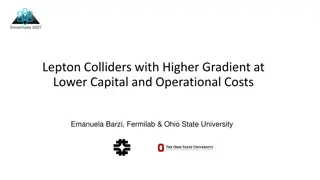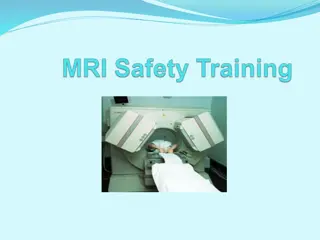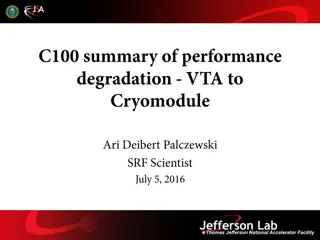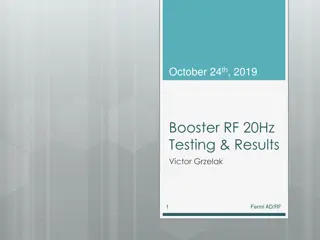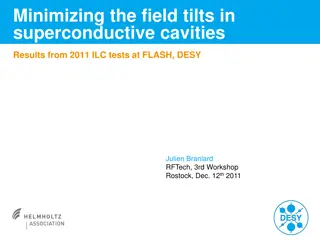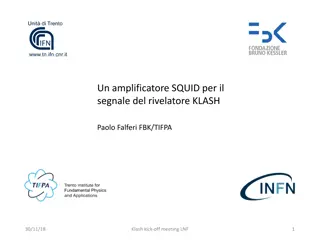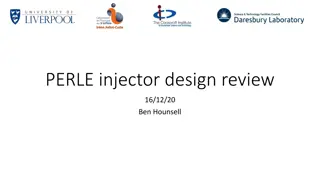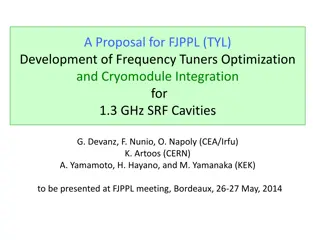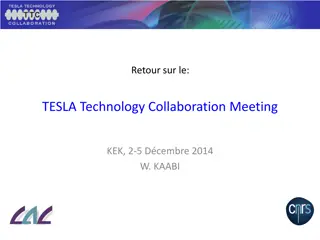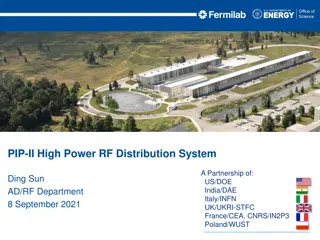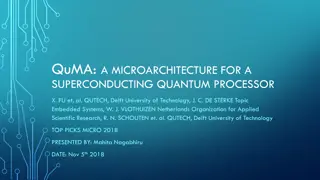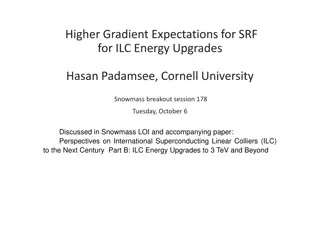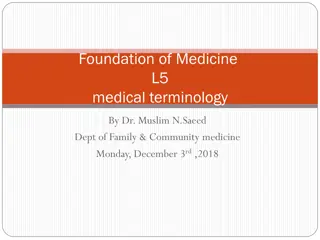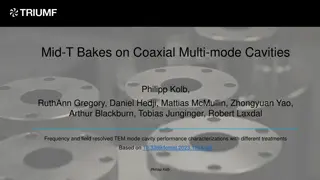Exploring Canted Cosine Theta with HTS Superconductors
This project delves into innovative superconducting magnets, particularly CCT in HTS, aiming to form strategic partnerships for HTS magnet technology in accelerators. Tasks include coordination, engineering designs, and construction of demonstrator magnets. The project also focuses on the conceptual
0 views • 16 slides
Overview of ESRF-EBS 352 MHz RF System Upgrade at 26th ESL RF Meeting
The 26th ESL RF Meeting held at Elettra in Trieste discussed the status and upgrades of the ESRF-EBS 352 MHz RF system. The meeting covered topics such as the EBS RF layout, HOM damped cavities, RF ECO-Mode, ongoing RF projects, and the replacement of klystrons with SSAs for a 4th harmonic RF system
0 views • 16 slides
Advanced Instrumentation and Diagnostics for Superconducting Magnets at CERN
Explore the crucial needs for instrumentation and diagnostics at CERN, focusing on superconducting magnets. Topics include voltage and strain measurements, vibration analysis, temperature sensing, quench detection, and magnet form factor considerations. The importance of advanced diagnostics and com
1 views • 23 slides
Basic Principles of MRI Imaging
MRI, or Magnetic Resonance Imaging, is a high-tech diagnostic imaging tool that uses magnetic fields, specific radio frequencies, and computer systems to produce cross-sectional images of the body. The components of an MRI system include the main magnet, gradient coils, radiofrequency coils, and the
2 views • 49 slides
Advancements in Superconducting Solenoid Technology for Klystrons at CERN
Research highlights the first operation of a klystron equipped with a superconducting MgB2 solenoid, aiming to enhance efficiency and sustainability of klystron systems. The focus is on integrating novel solenoid designs, such as those proposed by A. Yamamoto, to optimize klystron performance at CER
5 views • 18 slides
Overview of PED Compliance Requirements for RFD Crab Cavities Fabrication at FNAL
The process of ensuring PED compliance for RFD crab cavities fabricated by FNAL involves a review of EN and ASME Codes, with additional requirements set by CERN HSE. A formal agreement is being finalized, with a document defining essential safety requirements, risk assessment, and more. Additional r
5 views • 13 slides
Innovative Superconducting Cavities Research Project Overview
This project, funded by the European Union's Horizon 2020 program, focuses on innovative superconducting cavities coated with superconducting films. Objectives include optimizing production procedures, testing prototypes, and reducing costs. Tasks involve coordination, strategy development, and achi
2 views • 9 slides
Cryostat Engineering for SC Devices Training at CERN - November 2022
Explore the technical training on Cryostat Engineering for Superconducting devices at CERN in November 2022. Dive into the design aspects, static heat loads, and mass flows for a 400 MHz cryomodule. Tasks include conceptual design of cryostats, calculating thermal parameters, supporting systems, and
0 views • 10 slides
Purulent Diseases of Serous Cavities: Understanding Purulent Pleurisy and Empyema Pleurae
Purulent diseases of serous cavities, specifically purulent pleurisy and empyema pleurae, are marked by the secondary nature of inflammation in the parietal and visceral pleura. The classification details the etiology and clinical variations, while the pathogenesis explains the development from vari
0 views • 31 slides
Understanding Superconductivity: A Key to Zero Resistance
Superconductivity is a fascinating phenomenon observed in certain materials where electrical resistance disappears and magnetic fields are expelled. At critical temperatures, materials become superconductors, allowing electricity to flow with zero resistance. This occurs due to electron pairs called
1 views • 28 slides
Understanding NMR Spectroscopy in Pharmaceutical Analysis
Introduction to acquiring a 1H NMR spectrum in pharmaceutical analysis, including the role of magnetic fields, use of superconducting materials, and the principles behind NMR spectrometers.
0 views • 22 slides
Laser-Controlled Competing Superconducting and Charge Orders in Transition Metal Dichalcogenides
Hamburg Theory of laser-controlled competing superconducting and charge orders explores the use of lasers to manipulate the ordering mechanisms in transition metal dichalcogenides, leading to ultrafast switching and the induction of new states of matter. This research delves into generic mechanisms
0 views • 13 slides
Exploring 3D Transmon Qubits in Quantum Computing
This document delves into the initialization, read-out, and measurement techniques of 3D transmon qubits as integral components of quantum computing. It covers the underlying principles of superconducting qubits, SRF cavity utilization, and the roadmap for improving quantum memory and coherence time
0 views • 12 slides
Neutrino Interactions with Liquid Argon at DUNE Near Detector Complex
The Deep Underground Neutrino Experiment (DUNE) aims to study neutrino oscillations using high-precision measurements with detectors like the Near Detector complex located downstream of the neutrino beam. Components such as ND-LAr and SAND play crucial roles in scanning energy spectra. SAND, a perma
0 views • 16 slides
Insights into XFEL Cavities Production and Vacuum System Challenges
The discussions at TTC Meeting in Saclay shed light on companies' experiences during XFEL cavities production, revealing operational challenges related to vacuum plants and RGAs. The use of different firm RGAs resulted in distinct effects on RGA behavior, affecting signal/noise ratio and calibration
0 views • 24 slides
Investigation of Self-Organized Criticality Dynamics in Low Energy Threshold Ionization Detectors
Exploring the effects of energy accumulation in materials in detectors for coherent neutrino scatter, dark matter searches, and superconducting sensors and qubits. Focus on condensed matter effects, responsivity, background, and a hypothesized universal condensed matter mechanism. Touches on energy
0 views • 16 slides
Insights on the Future of SRF Technology by Peter Kneisel at Jefferson Lab
Peter Kneisel reflects on the past and present advancements in superconducting radiofrequency (SRF) technology, debunking the notion that Niobium has reached its limit. He discusses ongoing improvements in SRF cavities, surface treatments, and fabrication techniques, highlighting the need for cost r
1 views • 20 slides
Magnetization, Decay, and Error Fields in HTS Accelerator Magnets
The research conducted at The Ohio State University focuses on understanding the magnetization, decay, and influence of error fields in high-temperature superconducting (HTS) accelerator magnets. The study explores the impact of different superconducting materials such as Nb3Sn, YBCO, and Bi:2212 on
0 views • 21 slides
Challenges in Material and Component Harmonization
The presentation discusses the challenges faced in harmonizing materials and components in the production of RF superconducting cavities and cables. It highlights the impact of standards, the tendering process, and the need for usable standards to streamline discussions and interpretations. The pres
0 views • 14 slides
Understanding Magnetic Shielding Considerations for 3.9 GHz Cavities
This document discusses Q and magnetic shielding considerations for 3.9 GHz cavities used in the LCLS-II project, highlighting the unique behavior observed in nitrogen-treated cavities. The study delves into the improved Q values and field dependence of quality factors, challenging traditional niobi
0 views • 10 slides
Single Cell Cavity Activity Overview
The Single Cell Cavity Activity includes ANL EP optimization, R&D cavities for various processes such as tumble, laser re-melting, CMP, ECS investigation, and manufacturing optimization. There are also activities related to Atomic Layer Deposition (ALD) cavities, traveling wave cavities, vendor qual
0 views • 4 slides
Challenges and Upgrades in Electron-Ion Collider Interaction Regions
The article discusses vacuum issues, design challenges, and experiences in the interaction regions of Electron-Ion Colliders. It explores the unique characteristics of the HERA collider, including beam currents, bunch spacing, and straight sections. Additionally, it covers the upgrades and improveme
0 views • 25 slides
Collaboration Between Indian Institutions and Fermilab for Magnet Production
Collaboration between Indian institutions and Fermilab for the production of various magnets for the Medium Energy Beam Transport line, including warm and superconducting magnets. Updates on the progress, deliverables, recommendations for series production, and key milestones discussed during the 1s
0 views • 12 slides
Magnetic Field System in the nEDM@SNS Experiment
The presentation discusses the magnetic field system requirements, layout, and components for the nEDM@SNS experiment, highlighting the importance of coil uniformity, shielding, and superconducting materials to achieve accurate measurements of neutron electric dipole moments.
0 views • 26 slides
Long-term Operation of Superconducting Triplet Quadrupoles (STQ) with Cryocoolers at RIKEN
Introduction to the operational experiences, maintenance, and long-term operation of the Superconducting Triplet Quadrupoles (STQ) with cryocoolers for the BigRIPS In-flight Separator at RIKEN. Details include standard operation of SC magnets, unique features of BigRIPS and RI-beam delivery lines, S
0 views • 16 slides
Advancements in Lepton Colliders Technology
Emanuela Barzi and co-authors have made significant progress in developing lepton colliders with higher gradients at lower capital and operational costs. Their research focuses on using Superconducting Nb3Sn coated Cu RF cavities, parallel-feed RF structures, and innovative technologies to achieve h
0 views • 9 slides
Understanding MRI Machine Safety and Considerations
MRI machines utilize powerful magnets and advanced technology for medical imaging. The magnets are superconducting, requiring ultra-cold temperatures for operation, and safety considerations include managing biological effects, area effects, and cryogenic gases. The magnetic fields used in MRI scans
0 views • 20 slides
Quality Control and Testing Procedures for Superconducting Radiofrequency Cavities
The presentation highlights the rigorous processes involved in qualifying superconducting radiofrequency (SRF) cavities for high-performance applications. Each cavity undergoes a detailed qualification process, including BCP treatment, electropolishing, and high-pressure rinsing, to ensure optimal p
0 views • 18 slides
Booster RF 20Hz Testing & Results Summary
The Booster RF 20Hz Testing & Results conducted on October 24th, 2019 involved thermal scans and testing of power supplies and cavities for running at 20Hz. The testing highlighted concerns with power distribution and the potential for bus bars to get hot under load, requiring further investigation.
0 views • 30 slides
Minimizing Field Tilts in Superconductive Cavities: 2011 ILC Tests at FLASH
Understanding the importance of achieving flat gradients in superconductive cavities, the 2011 ILC tests at FLASH led by Julien Branlard focused on minimizing field tilts. Various solutions and test approaches were explored to address the issue, with results indicating the impact of cavity tilt and
0 views • 25 slides
Understanding the Superconducting Quantum Interference Device (SQUID)
The Superconducting Quantum Interference Device (SQUID) is a crucial component for detecting signals in devices like the KLASH detector. By combining Flux Quantization and Josephson Tunneling, the SQUID operates based on key principles such as the Josephson Equations and the Flux Quantum. Through ca
0 views • 23 slides
Overview of PERLE Injector Design & ALICE Electron Gun Re-optimisation
The PERLE injector, part of the Powerful Energy Recovery Linac for Experiments (PERLE), operates at 7 MeV injection energy with a bunch charge of 500 pC and a bunch repetition rate of 40.1 MHz. The layout includes a DC photoemission electron gun, bunching and focusing sections, and a superconducting
0 views • 50 slides
SRF Cavities and Cryomodules Workshop Details
This workshop provides information on SRF cavities and cryomodules, bringing together experts to address key engineering decisions, microphonic issues, and noise reduction techniques. Attendees can expect engaging sessions, networking opportunities, and valuable insights into the latest developments
0 views • 11 slides
Development of Frequency Tuners Optimization for SRF Cavities
Frequency tuners are crucial for adjusting the fundamental frequency of superconducting RF cavities to counteract detuning effects. The proposal discusses the importance of tuners, their operational mechanisms, and the challenges in achieving high reliability for efficient cavity operation. Various
0 views • 14 slides
TESLA Technology Collaboration Meeting at KEK December 2014
The TESLA Technology Collaboration (TTC) aims to promote R&D in RF superconducting technologies through collaborative meetings to address technical challenges and share developments. The recent meeting at KEK in December 2014 covered working groups on module tests, assembly, high Q0, cavity fabricat
0 views • 15 slides
PIP-II High Power RF Distribution System Overview
The PIP-II High Power RF Distribution System is a collaborative project involving various countries and institutions to develop a sophisticated system capable of efficiently distributing RF power to superconducting cavities. The system consists of multiple distribution lines and components designed
0 views • 28 slides
Overview of QuMA: A Microarchitecture for a Superconducting Quantum Processor
This paper introduces QuMA, a quantum microarchitecture that bridges the gap between high-level algorithms and the quantum physical layer. It defines a multi-layered system stack for quantum computers, focusing on compiler support, quantum error correction, and the need for a micro-architecture fram
0 views • 21 slides
Advancements in Superconducting Linear Colliders for ILC Energy Upgrades
Discussion on higher gradient expectations for SRF at the International Linear Collider (ILC) for energy upgrades beyond 3 TeV, highlighting advancements in single and multi-cell cavity gradients over three decades. Promising R&D paths include cold electropolishing, nitrogen infusion, advanced cavit
0 views • 15 slides
Major Body Systems and Cavities in Human Anatomy
Understanding the major body systems, including skeletal, muscular, cardiovascular, lymphatic, immune, respiratory, digestive, urinary, nervous, endocrine, reproductive, integumentary, and special senses systems, as well as the dorsal cavity comprised of the cranial and spinal cavities. Each system
0 views • 20 slides
Frequency and Field Resolved TEM Mode Cavity Performance Characterizations
This study focuses on the performance characterizations of TEM mode cavities with different treatments, including mid-T bakes and other processes. Investigations include the impact on Q0 and Eacc, sensitivities to magnetic fields, and strategies for improving medium field Q slope. The research aims
0 views • 19 slides
